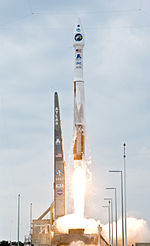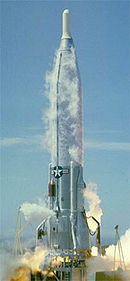Vandenberg Space Launch Complex 3
 The mobile launcher platform at SLC-3E rolls back prior to the launch of InSight in May 2018 | |||||||||||||||||||||||||
 | |||||||||||||||||||||||||
| Launch site | Vandenberg Space Force Base | ||||||||||||||||||||||||
|---|---|---|---|---|---|---|---|---|---|---|---|---|---|---|---|---|---|---|---|---|---|---|---|---|---|
| Location | 34°38′35″N 120°35′19″W / 34.6429885°N 120.5885124°W | ||||||||||||||||||||||||
| Time zone | UTC−08:00 (PST) | ||||||||||||||||||||||||
• Summer (DST) | UTC−07:00 (PDT) | ||||||||||||||||||||||||
| Short name | SLC-3 | ||||||||||||||||||||||||
| Operator | United States Space Force | ||||||||||||||||||||||||
| Total launches | 126 | ||||||||||||||||||||||||
| Launch pad(s) | 2 | ||||||||||||||||||||||||
| Orbital inclination range | 51° – 145° | ||||||||||||||||||||||||
| |||||||||||||||||||||||||
Space Launch Complex 3 (SLC-3) is a launch site at Vandenberg Space Force Base that consists of two separate launch pads. Space Launch Complex 3 East (SLC-3E) was used by the Atlas V launch vehicle before it was decommissioned in August 2021 with the final launch taking place on November 10, 2022, at 09:49, while Space Launch Complex 3 West (SLC-3W) has been demolished.[1]
Launches from Vandenberg fly southward, allowing payloads to be placed in high-inclination orbits such as polar or Sun-synchronous orbit, which allow full global coverage on a regular basis and are often used for weather, Earth observation, and reconnaissance satellites. These orbits are difficult to reach from Cape Canaveral Space Force Station, where launches must fly eastward due to major population centers to both the north and south of Kennedy Space Center. Avoiding these would require hugely inefficient maneuvering, greatly reducing payload capacity.[2]
SLC-3E was the launch site of the Mars lander InSight in May 2018.[3]
SLC-3E

History
One of two Atlas-Agena pads at VAFB, SLC-3E was originally the designated facility for MIDAS (Missile Defense Alarm System) launches and hosted its first flight on July 12, 1961. After the MIDAS program ended in 1966, SLC-3E then hosted reentry vehicle tests in 1967-68 as part of Project PRIME. The pad was mothballed for a decade, then returned to use in the late 1970s for NAVSTAR communications satellites on refurbished Atlas E/F missiles. On December 19, 1981, Atlas 76E crashed a few hundred feet from the pad after an engine failure, but no serious damage resulted to facilities. SLC-3E was then converted for the Atlas H (Atlas-Centaur core with a solid upper stage in place of the Centaur) and hosted ELINT satellite launches from 1983-87. The pad was mothballed once again and not used for the next 12 years, when it was revived for the Atlas IIAS.
Three successful Atlas IIAS missions were flown from SLC-3E. The first mission, flown on December 18, 1999, launched the Terra satellite.[4] The other two launched satellites in the Naval Ocean Surveillance System, USA 160 and USA 173.[5][6] The final Atlas IIAS mission from SLC-3E was launched on December 2, 2003.[7]
It was reported in 2003 that SLC-3E would be overhauled to serve as a launch platform for the Atlas V.[8] Renovations of SLC-3E began after a January 2004 ground breaking ceremony. Along with other work, the Mobile Service Tower roof was raised by approximately 30 ft (9.1 m) to a height of 239 ft (73 m) to accommodate an Atlas V 500 series vehicle with its larger payload fairing.[9] In July 2004, Lockheed Martin announced the arrival of the fourth and final segment of the fixed launch platform (FLP). The segments had been transported from a fabrication facility in Oak Hill, FL, 3,500 miles (5,600 km) away. The largest segment weighed 90 tons and was "thought to be the biggest over-the-road shipment ever attempted cross-country."[10] In February 2005, the activation team handed over the launch pad to the operational team, marking the end of major reconstruction.[11] The first Atlas V launch from SLC-3E took place at 10:02 GMT on March 13, 2008.[12]
United Launch Alliance (ULA) inherited the pad in December 2006 when the company was formed as the joint venture of Lockheed Martin and Boeing, and continued to use it to fly Atlas V rockets. In October 2015 ULA announced that the pad would be updated to accommodate the upcoming Vulcan Centaur rocket, with the pad then being able to launch either Atlas V or Vulcan.[13] The final Atlas V launch from the pad took place on November 10, 2022, carrying the JPSS-2 satellite.[14] The first flight of Vulcan from SLC-3E was anticipated to be in 2023,[15] but Vulcan has been delayed and the first flight from SLC-3E is now expected in 2025.[16]
Launch history (3E)
SLC-3W

SLC-3W was originally built for Atlas-Agena launches and the first flight off the pad was the launch of Samos 1 on October 11, 1960. The facility was extensively damaged 11 months later when Samos 3's booster exploded on the pad, but it was repaired quickly and hosted its next launch slightly under two months afterwards.
In 1962-63, the pad was converted for Thor-Agena use and was the primary launching site for Corona reconnaissance satellites for the next decade. After the Corona program ended in 1972, SLC-3W was converted back to support Atlases, this time flights of refurbished Atlas E/F missiles. The final such launch took place in 1995.
SpaceX initially planned to use SLC-3W for the Falcon 1 launch vehicle but switched to SLC-4E with Falcon 9.[17]
Launch history (3W)
See also
- Canyon Fire (2016) – 2016 wildfire in Southern California
- Vandenberg Space Launch Complex 2 – Rocket launch site at Vandenberg Space Force Base in the USA
- Vandenberg Space Launch Complex 4 – Rocket launch complex at Vandenberg Space Force Base in the United States
- Vandenberg Space Launch Complex 6 – Launch pad
References
- ^ Ray, Justin (January 20, 2000). "Vandenberg launch pad demolition set for Sunday". Spaceflight Now. Retrieved September 27, 2022.
- ^ "Launch Sites". NASA Human Spaceflight Office. Archived from the original on October 13, 1999.
- ^ Clark, Stephen (December 19, 2013). "Mars lander to launch from California on Atlas 5 in 2016". Spaceflight Now. Retrieved December 20, 2013.
- ^ NASA – NSSDC – Spacecraft – Details. NASA.
- ^ NASA – NSSDC – Spacecraft – Details. NASA.
- ^ NASA – NSSDC – Spacecraft – Details. NASA.
- ^ "ILS Successfully Launches Atlas IIAS with NRO Payload". International Launch Services. December 2, 2003. Retrieved March 16, 2013.
- ^ Justin Ray (December 4, 2003). "Vandenberg's Atlas Launchpad Getting Extensive Facelift".
- ^ "Lockheed Martin Begins Atlas V West Coast Launch Pad Renovations SLC 3E Being Readied for Atlas V Missions in Fall 2005". LM. January 14, 2004. Archived from the original on August 13, 2011.
- ^ "Lockheed Martin Marks Major Milestone At West Coast Atlas V Launch Pad". PR Newswire. July 27, 2004.
- ^ "Lockheed Martin Delivers First Atlas Five Booster to West Coast Launch Site". Lockheed Martin. February 11, 2005. Archived from the original on May 25, 2011.
- ^ "ULA Inaugural Atlas V West Coast Launch a Success". ULA. Associated Press. March 13, 2008. Retrieved November 24, 2022.
- ^ Clark, Stephen. "ULA selects launch pads for new Vulcan rocket – Spaceflight Now". Retrieved September 26, 2022.
- ^ Gebhardt, Chris (November 9, 2022). "Atlas rocket bids farewell to California as ULA readies for Vulcan". NASASpaceFlight. Retrieved November 10, 2022.
- ^ Gebhardt, Chris (August 21, 2020). "ULA updates Vulcan status, readiness for certification missions". NASASpaceFlight.com. Retrieved September 26, 2022.
- ^ Erwin, Sandra (June 8, 2023). "Space Force assigns 12 national security missions to SpaceX and ULA". SpaceNews. Retrieved June 8, 2023.
- ^ Federal Register /Vol. 73, No. 245 / Friday, December 19, 2008 / Proposed Rules, page 77579.
External links
- Historic American Engineering Record (HAER) documentation, filed under Napa and Alden Roads, Lompoc, Santa Barbara County, CA:
- HAER No. CA-133-1, "Vandenberg Air Force Base, Space Launch Complex 3", 15 photos, 164 data pages, 2 photo caption pages
- HAER No. CA-133-1-A, "Vandenberg Air Force Base, Space Launch Complex 3, Launch Operations Building", 120 photos, 11 photo caption pages
- HAER No. CA-133-1-B, "Vandenberg Air Force Base, Space Launch Complex 3, Launch Pad 3 East", 278 photos, 23 photo caption pages
- HAER No. CA-133-1-C, "Vandenberg Air Force Base, Space Launch Complex 3, Launch Pad 3 West", 183 photos, 16 photo caption pages
- HAER No. CA-133-1-D, "Vandenberg Air Force Base, Space Launch Complex 3, Vehicle Support Building", 21 photos, 3 photo caption pages
- HAER No. CA-133-1-E, "Vandenberg Air Force Base, Space Launch Complex 3, Technical Support Building", 8 photos, 1 photo caption page
- HAER No. CA-133-1-F, "Vandenberg Air Force Base, Space Launch Complex 3, SLC-3 Air Force Building", 4 photos, 1 photo caption page
- HAER No. CA-133-1-G, "Vandenberg Air Force Base, Space Launch Complex 3, Meteorological Shed and Tower", 5 photos, 1 photo caption page
- HAER No. CA-133-1-H, "Vandenberg Air Force Base, Space Launch Complex 3, Traffic Check House", 1 photo, 1 photo caption page
- HAER No. CA-133-1-I, "Vandenberg Air Force Base, Space Launch Complex 3, Sewage Treatment Plant", 1 photo, 1 photo caption page
- HAER No. CA-133-1-J, "Vandenberg Air Force Base, Space Launch Complex 3, Entry Control Point", 5 photos, 1 photo caption page
- HAER No. CA-133-1-K, "Vandenberg Air Force Base, Space Launch Complex 3, Storage Shed", 2 photos, 1 photo caption page
- HAER No. CA-133-1-L, "Vandenberg Air Force Base, Space Launch Complex 3, Storage Shed", 4 photos, 1 photo caption page
- HAER No. CA-133-1-M, "Vandenberg Air Force Base, Space Launch Complex 3, Pyrotechnic Shed", 6 photos, 1 photo caption page
- HAER No. CA-133-1-N, "Vandenberg Air Force Base, Space Launch Complex 3, Azimuth Alignment Shed", 2 photos, 1 photo caption page


